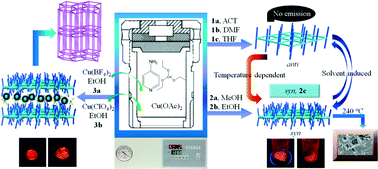Crystal-to-crystal transformations and photoluminescence changes in the Cu(i) coordination networks based on a formamidinate ligand†
Abstract
One-pot solvothermal reactions of 4-aminopyridine and triethylorthoformate with Cu(O2CCH3)2 in acetone (ACT), dimethylformamide (DMF), tetrahydrofuran (THF), methanol (MeOH) and ethanol (EtOH) afforded 2D coordination networks, anti-{[Cu(4-pyf)]·ACT}n, 1a, (4-Hpyf = N,N′-bis(pyridine-4-yl)formamidine), anti-{[Cu(4-pyf)]·DMF}n, 1b, anti-{[Cu(4-pyf)]·THF]}n, 1c, syn-{[Cu4(4-pyf)4]·2MeOH}n, 2a, and syn-{[Cu4(4-pyf)4]·2EtOH}n, 2b, whereas the reaction of Cu(O2CCH3)2, 4-aminopyridine, triethylorthoformate and CuX2 (X = BF4− and ClO4−) in ethanol gave the 3D coordination networks syn-{[Cu3(4-pyf)2](BF4)·2H2O·EtOH}n, 3a, and syn-{[Cu3(4-pyf)2](ClO4)·EtOH}n, 3b, which were characterized by X-ray crystallography. Complexes 1a–3b are the first 2D and 3D coordination networks showing closed-shell Cu(I)–Cu(I) interactions that are supported by the formamidinate ligands. Reversible crystal-to-crystal transformations were observed for the 2D anti- and syn-coordination networks upon solvent exchange. Irreversible anti to syn crystal-to-crystal transformations can be shown upon solvent removal and the important intermediate, syn-{[Cu4(4-pyf)4]·2THF}n, 2c, which verifies the temperature-dependent transformation, was structurally characterized. The configurations of the structures have significant influence on the emission properties. While the syn-complexes show broad emission bands, those of the anti-complexes are not detectable, indicating that cuprophilicity is unlikely to play significant roles in determining the emission of 1a–3b. The 2D anti- and syn-complexes that show outwardly dangling pyridyl rings may adsorb Cd salts through Cd–N interactions.


 Please wait while we load your content...
Please wait while we load your content...